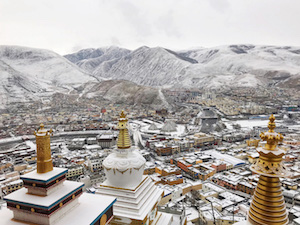| |
|
 |
Buddhist traditions and conservation programmes protect rare otters on Tibetan plateau
March 12, 2018:
 |
 |
 |
The Eurasian otter: camera trap photo |
In early 2018 Flora He Yifan volunteered at the Shanshui Conservation Center, working on Eurasion otter monitoring, human-wildlife conflict resolution, and ecotourism development in the Sanjiangyuan region in Qinghai, China. She is a recent Master’s graduate from the School of Environment and Sustainability, University of Michigan, and later this year will join Conservation International as a social science coordinator. Read the full report on Mongabay. This is a brief summary.
Buddhist traditions protect the rare Eurasian otter.Although the Eurasian otter (Lutra lutra) is locally extinct in most of its former range in China due to a combination of hunting (for its pelt) water pollution, and general habitat destruction, in one area there is a healthy population. In Yushu, Qinghai, a city of 200,000 people on the eastern Tibetan Plateau Buddhist traditions linked with conservation initiatives have helped preserve a healthy population of otters.
"Two rivers — Zhaqu and Changu — flow through the city to join the Tongtian River in the east, the headwater of the Yangtze river. During a one-month survey, researchers from Shanshui Conservation Center recorded Eurasian otter activities 66 times with seven camera traps. Over 200 spraints (otter dung) and footprints were also discovered along 45 kilometers (about 28 miles) of river, indicating a thriving population of the species.
Yushu is a Buddhist areaOne unique fact about Yushu, He Yifan writes, is that over 95 percent of its population is Tibetan. Consequently, this area is heavily influenced by Tibetan Buddhist traditions, which support the conservation of individual organisms and habitats in many ways.
A fundamental component of Buddhism is compassion for all living beings. It comes partly from the idea of reincarnation and the belief that an animal could be one’s parent, sibling, or friend in another life.
"While meat consumption is necessary for local herders to survive in the harsh climate of Tibet, many choose to eat larger animals like yaks, so that fewer lives are taken. For this reason, many locals do not eat fish or other aquatic creatures, securing ample food sources for the otters.
"Also, the locals believe that cutting trees on sacred mountains will offend mountain gods, and, similarly, polluting water sources will infuriate the water gods. By protecting sacred natural sites in Tibetan Buddhism, people are also conserving important wildlife habitats.
"What’s more, the demand for otter pelts in the Tibetan region has been drastically reduced in recent years due to the advocacy of religious leaders against the use of animal fur."
 |
 |
 |
Yushu city PHOTO: Chen Peng |
Combining religious traditions with effective conservationLutra lutra is now listed under CITES Appendix I and the Schedules of Nationally Protected Fauna and Flora in China, and stricter law enforcement has reduced hunting. Since the 1990s the Chinese government has set conservation as a priority in the Sanjiangyuan region, a 316,000-square-kilometer area that includes the headwaters of three great Asian rivers: the Yangtze, the Yellow, and the Mekong. Over 40 percent of the land has been designated as the Sanjiangyuan Nature Reserve, and a series of conservation projects are in place, including grassland restoration, a firearm ban, and anti-poaching measures. Being part of the Sanjiangyuan region, Yushu benefits greatly from these projects.
There are problems from traditional Buddhist practices in the regionIn the same rivers where the otters live, people have been releasing fish as a practice of sparing lives that were to be slaughtered. Most of these non-native fish die, but a few carp species appear to be doing well, raising concerns over invasive species. Conservationists working in this area must address these kinds of challenges in ways that the local people are willing to accept.
NOTE FROM ARC: Elsewhere in China, however, Buddhist leaders have recognised that Mercy Release is a problem for both the environment and the animals that suffer from it. They have alternatively promoted the concept that the best form of Mercy Release is adopting a vegetarian diet, either through your life, or on Buddhist special days. Read more here, including a cartoon for children.
Future plansWhile the otters in Yushu benefit from both Tibetan traditions and conservation actions, they still face a number of threats, including levee construction, water pollution, and growing traffic in the city. To better understand the impact of human activities on the otter population, Shanshui Conservation Center will continue its efforts in monitoring and research. Eventually, Center staff hope to inform actions such as habitat restoration, anti-poaching, and native fish conservation, based on their findings, He writes.
Links to other successful Buddhism and Conservation programmesThe Snow Leopard Foundation leads workshops with Buddhist monks and nuns in Ladakh and Zanskar
Mongolian monks lead conservation projects
Bhutan Compassion and Conservation conference
"The best mercy release is a vegetarian diet".
"The Karmapa's Guidelines for the Environment.
17th Karmapa holds landmark Buddhist Environment Conference.
|
 |
 |
|
|
|
|
|

